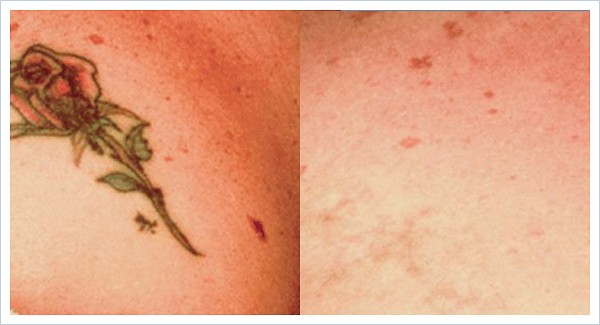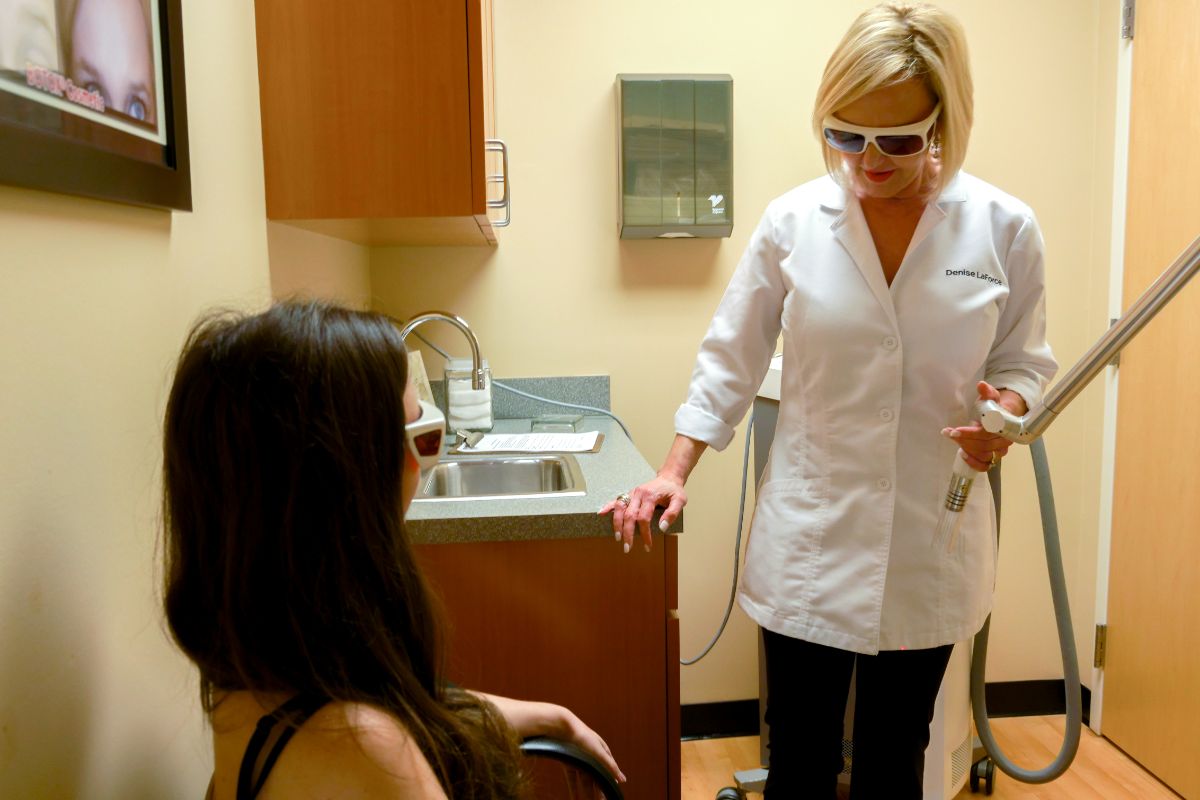Nobody makes it through life without an ill-advised decision or two. But when one of those mistakes is immortalized in a tattoo, it can make it a whole lot harder to forget! Whether it’s an ex’s name, an image that hasn’t held up well over time, or a symbol for something you’d rather not be reminded of, some tattoos simply don’t make the cut. Fortunately, you don’t have to spend a lifetime with a tattoo you hate!
Here at Dermatology Realm, we’re proud to offer laser tattoo removal to patients across Memphis and the Mid-South. Although most people are aware that laser removal exists, there’s still a lot of confusion and misconceptions out there about how the procedure actually works. If you’ve ever considered having a tattoo removed, keep reading below as we cover all the basics you need to know before making your decision.
What is laser tattoo removal?
There are multiple ways to remove tattoo ink from the skin, but laser removal is the most effective method, and certainly the most popular. This is due in large part to the high success rates and lack of any serious side effects. Technological advances over the last several years have made this removal process much more affordable and mainstream, but it still remains a bit of a mystery to the general public.
The truth is that ink particles in the skin are very difficult to remove. Consider this: your body views those particles as foreign objects and is constantly trying to break them down and eliminate them using an army of white blood cells, but they just can’t get the job done! That’s because the ink particles are so much bigger and tougher. The most the white blood cells can do is slowly erode the ink, which is why all tattoos fade with enough time.
Those particles are clearly tough stuff, and that’s why we have to use something as strong as a laser to remove them. Not just any laser will do, however. Tattoo removal requires a specialized ultrashort pulse laser, which works by emitting very hot blasts in quick bursts to heat up and break apart the ink particles.
The pigment of the ink makes a difference as well. Because different pigments will absorb different wavelengths of light, the laser must be set to the right wavelength in order to break down the ink. Tattoos that have different pigmentation will require more than one adaptor to break down each type of ink particle.
Remember those white blood cells that stay busy attacking the ink particles? Here’s where they finally have their moment of glory! Once the laser breaks the ink down into small enough particles, the white blood cells are able to seize them and carry them to the liver, where they will be flushed out along with any other foreign objects or toxins.
Laser tattoo removal is a very effective procedure, and will work for almost anyone. Be aware, though, that it is not a “one and done” procedure. It will generally take multiple sessions to completely remove any tattoo.
How many sessions will it take to remove a tattoo?
There’s no “one size fits all” answer to this, but the average number of sessions is anywhere from six to twelve, depending on the specifics of your particular tattoo. Rarely, a removal may require a dozen or more sessions, but this isn’t the norm. You’ll need to give your body time to heal between each session, usually at least six weeks. This gives you time to recover from any temporary damage done by the laser, and is also when your body will flush out the broken down ink particles.
There are a few factors that will determine how many laser removal sessions you need in total. We’ll outline them below.
The colors in the tattoo
The color of your tattoo will play a big role in how effective laser removal will be. Darker pigments take fewer sessions to break down than lighter ones. Why? A laser is basically amplified light, and like any black surface, dark or black ink will absorb the most light. That means the laser will be at its most effective on tattoos that are primarily black or dark ink colors.
Tattoos that are composed of lighter colored inks are more reflective, so the light bounces off them. When less light is absorbed, the laser becomes less effective. For example, yellow and purple ink are notoriously difficult to remove and may require a few extra sessions for the best results.
The location of your tattoo
The parts of your body with the most blood circulation are where tattoos will fade the fastest. That’s why tattoos that are further away from your heart, like those on your hands or feet, will look more vibrant for a longer period of time. Removing a tattoo from somewhere on your torso will be easier than removing one from your arms or legs.
How long you’ve had the tattoo
Although tattoos are permanent, they do fade over time. The older and more your tattoo is faded, the fewer sessions it will take to remove it.
It’s important to have realistic expectations about the laser removal process. If you require, say, eight sessions, and have at least six weeks of healing between each one, the entire process will take about a year.
Is laser tattoo removal painful?
Laser removal involves applying extremely hot, concentrated light to your skin—it’s not a walk in the park, that’s for sure! But everyone’s tolerance for pain is different. Some people who have undergone laser removal have experienced significant discomfort, while others say it’s comparable to getting the tattoo in the first place. There can also be some lingering soreness after each session. This is usually similar to what you’d feel with a small burn or blister.
Are there any side effects from laser tattoo removal?
As long as the removal procedure is performed by an experienced medical aesthetician like specialist Denise, the process is completely safe. There is a chance of side effects, however, and it’s important to be aware of those before making your decision.
Hyperpigmentation and hypopigmentation
The most common side effect for most people undergoing laser tattoo removal is a change in the skin pigmentation, especially for those who have darker skin tones. Your body may respond to laser treatment by producing too much or too little melanin in the affected area. This can result in a darkening of the skin (hyperpigmentation) or a lightening of the skin (hypopigmentation.) These issues are cosmetic, and not associated with any adverse health effects. In most cases, any pigmentation changes will be temporary and should resolve themselves within 6-12 months of the laser removal process.
Skin sensitivity
Redness, tenderness, and swelling are common after the procedure. Some bruising and blistering can occur as well. Like pigmentation issues, these will resolve themselves naturally over time. While the treated area is healing, it’s at a greater risk for infection, so it’s very important to follow all of the recommendations you are given to minimize the risks of any adverse effects.
Scarring
Many people worry that laser removal will lead to noticeable scarring, but this is actually extremely rare. After-care does play a large role here, however. You should always ensure you’re taking the appropriate steps to treat the lasered area as directed, so it can heal properly. If blisters and scabs form, do not pick at them! This can result in permanent scarring.
Get the results you want from the experts at Dermatology Realm
If you’re looking to rid yourself of a tattoo you no longer want, laser tattoo removal is one of the safest and most effective ways to do so. Most sessions last 15 minutes to one hour and there’s no downtime involved. Since all sessions are outpatient, it’s easy to fit tattoo removal into your busy life! Get in touch today to schedule a free consultation.


